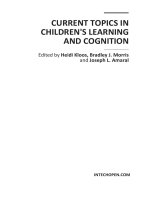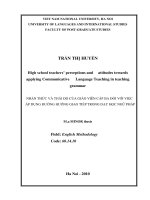COLLECTIVISM AND INDIVIDUALISM IN TEACHING AND LEARNING
Bạn đang xem bản rút gọn của tài liệu. Xem và tải ngay bản đầy đủ của tài liệu tại đây (122.11 KB, 7 trang )
<span class='text_page_counter'>(1)</span><div class='page_container' data-page=1>
<b>COLLECTIVISM AND INDIVIDUALISM IN TEACHING AND LEARNING</b>
<i><b> Summary</b></i>
Cultural variation has long been a theme of great concerns in education settings and
cultural studies. Culture flows and shifts between us; it both binds and separates us, but in
different ways at different times and in different circumstances (Holiday, 2005).
According to Hofstede (1997), culture differs along five dimensions: power distance,
individualism- collectivism, masculinity- femininity, uncertainty avoidance, and
short-term time orientation versus long-short-term time orientation. These dimensions were arrived in
his 1980 publication, "Culture's consequences: International differences in work-related
values." One of the most well-known cultural continuums is individualism versus
collectivism which has been the much debated topic in academic research and journals. In
individualist cultures, the individual is emphasized and independence valued (Dodd, 1998)
while the emphasis in on the well-being of the group in collectivist cultures. This paper
will look at some basic tenets of cultural variation in term of individualism and
collectivism in learning and educational settings.
<i><b>Key words: collectivism, individualism, educational settings, cultural variation</b></i>
<i><b>1. Collectivism versus individualism</b></i>
</div>
<span class='text_page_counter'>(2)</span><div class='page_container' data-page=2>
(Hofsetede, 1997). Some of the typical features of an individualist culture is that people
see themselves as independent individuals with independent relations emphasizing the
importance of ‘self’. Members of individualistic cultures are described as valuing personal
time, freedom, challenge, direct communication style, and materials rewards at work
(Hofstede, 1997). Triandis’s study (1995) also showed that the individualism is most often
a consequence of looseness and cultural complexity. Thailand is considered having a loose
culture because Thai culture is located at the interjections of major other countries (e.g.
Thailand is at the interjection of India and China). In Thailand, there is very little concern
with work rules and etiquette. If an employee is going to leave his or her place of
employment because of homesick or any other reason, he or she may leaves without
giving a formal resignation.
Collectivism pertains to society in which people from birth onwards are intergrated into
strong, cohesive in groups which continue to protect them throughout their lifetime in
exchange for unquestioning loyalty (Hofstede, 2003, p.51). According to Triandis (1995),
collectivism is most often a consequence of tightness and cultural simplicity. Japan is
considered a tight culture because people are socialized to act properly.
</div>
<span class='text_page_counter'>(3)</span><div class='page_container' data-page=3>
to take place in Western countries where the individualist culture influenced greatly on
every aspect of people’s lives.
In an individualist culture, a small nuclear family is seen very common, including parents
and children. As these children are grow-up, they often decide their study options by
themselves, tend to be independent, competitive in almost activities and willing to accept
challenges for individual success and accomplishment in their learning and later life. As
Dodd (1998) stated that “disagreement contrasting ways of thinking are considered
desirable, and the emphasis is on meeting personal needs and goals rather than thinking in
terms of the group”.
<b>2. Collectivist and individualist cultures in educational settings</b>
</div>
<span class='text_page_counter'>(4)</span><div class='page_container' data-page=4>
During my study period at the university of Newcastle where there are a lot of local
students and those who are from other countries with different cultural backgrounds, I
realize that many students, especially Australian and Western students possess the
characters of the individualist culture. They discussed their ideas and opinions without any
hesitation during the lesson. Lecturers also seem very willing to answer their questions in
the class. I also find that the students from Asian countries such as China, Vietnam and
Taiwan seldom raise questions to the teacher; instead, they prefer meeting the lecturers
after class if they are confused or do not understand some content of the lesson. Some
questions also come to my mind that whether the teachers or individualist learners
(including Australian students) see the collectivist learners as withdrawn or uninterested or
not? Do the teachers feel reluctant to ask the collectivist learners some questions about the
lesson? May the frequent questions to lecturers raised by individualist students be seen as
rude or impolite in the eyes of their collectivist classmates? As a matter of fact, the
cultural differences among the students from different countries can lead to
misunderstanding across cultural groups.
</div>
<span class='text_page_counter'>(5)</span><div class='page_container' data-page=5>
the virtue of harmony reigns supreme. Confrontation and conflicts are to be avoided.
(Hofstede, 2005). Several studies also show that Chinese students, in a group setting,
always try to avoid conflicts, losing one’s face and tend to maintain group harmony. A
study conducted by Phuong Mai (2005) showed that Vietnamese students also tend to
“appreciate the one-for-all mentality”, that is, every member of the group try not to raise
different opinions, but should sacrifice for the sake of group harmony. Vietnamese people
have some proverbs expressing this character: “One time self-denial means nine times
goodness”; “Think seven times before speaking out”; “Words cost no money, use them
well to please others”.
</div>
<span class='text_page_counter'>(6)</span><div class='page_container' data-page=6>
spirit among the learning groups but always try to avoid conflicts and maintain the
harmony in the class. However, there is the tendency that most Vietnamese students are
used to studying individually and independently and they prefer this learning style. They
also find it easier to figure out new things by themselves rather than working in groups
because they are able to control their critical thinking more effectively to have better
learning results. In other words, their study was set up individually with no collective
target.
<b>3. Conclusion</b>
Hofstede’s notions on individualism and collectivism provide teachers useful and essential
understanding about the different learning styles among the students with different cultural
backgrounds. From this perception, teachers become more aware of designing the study
programs, teaching strategies and classroom activities which should be appropriate for
both individualist and collectivist students. It can be said that when the teachers have a
thorough understanding about students’ cultural needs, learners can get the best benefits in
their studies.
<i><b>Tóm tắt</b></i>
</div>
<span class='text_page_counter'>(7)</span><div class='page_container' data-page=7>
<i>nghĩa tập thể, nam tính - nữ tính, mức độ e ngại rủi ro, và định hướng ngắn hạn - định</i>
<i>hướng dài hạn. Những khía cạnh này đã được bàn luận trong ấn phẩm năm 1980 của</i>
<i>ông, "Những hậu quả của văn hố: Những khác biệt mang tính quốc tế trong các giá trị</i>
<i>liên quan đến công việc." Một trong những khái niệm văn hoá phổ biến nhất là chủ nghĩa</i>
<i>cá nhân và chủ nghĩa tập thể và đây là chủ đề được bàn luận khá nhiều trong các nghiên</i>
<i>cứu và tạp chí học thuật. Trong văn hố theo chủ nghĩa cá nhân, cá nhân được nhấn</i>
<i>mạnh và sự độc lập được đề cao trong khi văn hóa theo chủ nghĩa tập thể tập trung vào</i>
<i>sức mạnh của một nhóm người. Bài viết này xem xét một số nguyên lý cơ bản của sự đa</i>
<i>dạng văn hoá về chủ nghĩa cá nhân và chủ nghĩa tập thể trong học tập và mơi trường giáo</i>
<i>dục nói chung.</i>
<i><b>Từ khóa: chủ nghĩa tập thể, chủ nghĩa cá nhân, sự đa dạng văn hoá, mội trường giáo dục</b></i>
REFERENCES
[1] Al-Issa, A. (2005). When the West teaches the East: Analyzing intercultural conflict in
<i>the classroom. Intercultural Communication Studies, 4, 149-164.</i>
<i>[2] Hofstede, G. (1997.) Cultures and Organizations: Software of the mind. NewYork:</i>
Harcourt.
<i>[3] Hofstede, G. (1986). Cultural differences in teaching and learning. International</i>
<i>Journal of Intercultural Relations, 10, 301- 320.</i>
[4] Phuong-Mai, N., Terlouw, C. & Pilot, A. (2005). Cooperating learning vs. Confucian
<i>Heritage Culture’s Collectivism, Asian Europe Journal, 3, 403-409.</i>
[5] Phuong-Mai, N., Terlouw, C. & Pilot, A. (2006). Cultural appropriate pedagogy: the
<i>case of group learning in a CHC context. Intercultural Education, 17, 1-19.</i>
</div>
<!--links-->









